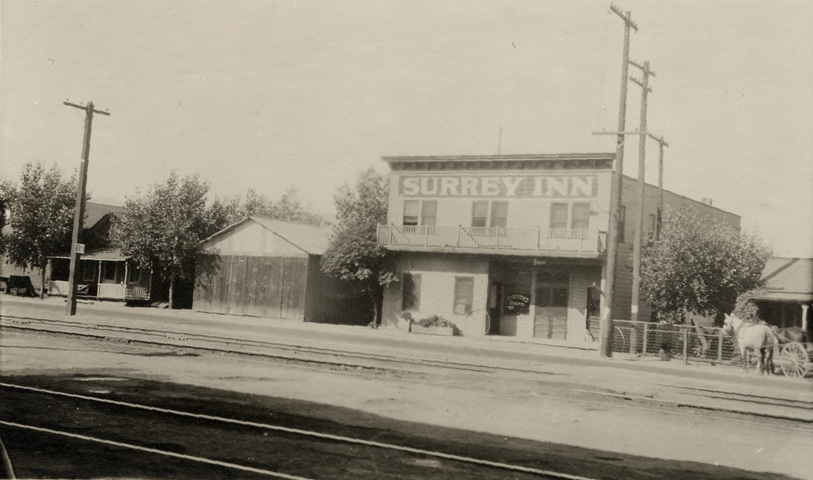|
|
HISTORY OF THE SANTA CLARITA VALLEY BY JERRY REYNOLDS
[NEXT] [PREVIOUS] [CONTENTS] [SEARCH]
SAUGUS / SURREYSEE ALSO:
BERCAW FAMILYBercaw Store 19071910sSurrey Inn ~1910sSurrey Postmark 1912L.A. Aqueduct Letter 1912Surrey Postmark 1910sSurrey Inn 1920s19217-25-19313-29-1936~1964
46. Surrey

Ore W. Bercaw opened the two-story Surrey Inn in 1911. Click to enlarge.Two miles north of Newhall, a trainload of dignitaries chugged to a stop to dedicate the Saugus Train Station. The date was September 1, 1887, and theirs was the first run over a spur line that would eventually stretch beyond Ventura up the coast to Santa Barbara and San Francisco.
On board were David D. Colton, president of Southern Pacific, several mayors and the governor of California, Washington Bartlett. They were welcomed by John T. Gifford, Southern Pacific's agent in Newhall, since no one had yet been appointed to that post in Saugus.
The name of the new depot was chosen by Henry Gregory Newhall for the little town in Massachusetts where his father, Henry Mayo Newhall, had been born. "Saugus" is the Narragansut tribal word for a sandy spit of land.
Henry G. Newhall, then 34, was president of The Newhall Land and Farming Company, which had given the railroad the right-of-way for its westward spur line.
The depot — which now rests in Heritage Junction at William S. Hart Park in Newhall — was completed early in 1888 with prefabricated redwood hauled down from the north. Alexander Isaac Frazier was assigned as agent and served two years. Joseph H. Tolfree started the Saugus Eating House (alternately known as Tolfree's Eating House) in the baggage room; the enterprise would later be known as the Saugus Cafe.
On August 5, 1891, the Soledad Post Office was moved down out of the canyon to the Saugus Station. Earlier that same year, on April 25, a special train draped with American flags rolled up to the Saugus Station to take on water. President Benjamin Harrison was passing through on a whistle-stop campaign for reelection. The president sported a bandaged hand, injured while moving from one car to another. A delegation from Santa Barbara met the president at Saugus, then steamed down to Ventura, making brief stops at Fillmore and Santa Paula.
In 1898 a Southern Pacific employee named Richard R. Wood took an option on Tolfree's Eating House and a chunk of land to the west of the railroad tracks. On January 18, 1899, his brother Martin Wood joined him from Terminal Island; Martin co-signed the deed, took active management of the eatery, and gave it its present name.
President Theodore Roosevelt came through in May 1903 and dined on a special New York steak, declaring it "splendid," legend says. The following year the indomitable chief of the Los Angeles Department of Water and Power, William Mulholland, and former Mayor Fred Eaton stopped by for breakfast on their way to inspect the liquid assets of the Owens Valley. Driving a rickety buckboard, they had spent a hard night of drinking in a Newhall saloon before heading northward on a mission that would have far-reaching consequences for Los Angeles County.
In 1905 Martin Wood moved the Saugus Cafe to roughly its current location, west of present Bouquet Canyon Road. Next door his brother, Richard, ran a blacksmith shop that would become a garage and gas station. The pair built homes for their families, a small rooming house, and a general store.
Ore W. Bercaw became Saugus station master in 1906 and, for reasons long forgotten, changed the name of the post office to Surrey — a name that would last until October 12, 1915. In rapid succession Bercaw built an ice house (1909), the Surrey Inn (1911), a garage and the Bercaw Store, south of the Woods' holdings.
As the families established themselves they needed a school. Charles and Anita Kellogg — she, the daughter of Bill Jenkins of Castaic — farmed the tract from present-day Magic Mountain Parkway up to Bouquet Junction and donated land for a school in 1907. The Bercaws, Woods and Osbornes put up one hundred dollars each and built a wooden, New England-style structure with belfry. Margaret O'Connell came from San Jose to be the first teacher.
Marlin Seltzer recalls that ringing the school bell was a great honor. He would get there first thing in the morning to tug on the long rope.
On the other hand, George Shaffner remembers the pot-bellied, wood-burning stove in the middle of the classroom. When some of the boys decided they needed an afternoon off, they would gather around during lunch and urinate on the coals. The stench was intolerable, and everyone was sent home.
The children obviously took after their elders. Helen Wood Cone recalls the cowboys at the turn of the century who would thunder into town on the backs of half-wild horses and raise all sorts of commotion. One day in 1899 they took potshots at the Saugus Station; it was their way of greeting a northbound train.
Helen and her husband, Bryon Cone, ran the Saugus Cafe in the 1920s and 1930s. Today it is the oldest existing restaurant in Los Angeles County.
©1998 SANTA CLARITA VALLEY HISTORICAL SOCIETY · RIGHTS RESERVED.
The site owner makes no assertions as to ownership of any original copyrights to digitized images. However, these images are intended for Personal or Research use only. Any other kind of use, including but not limited to commercial or scholarly publication in any medium or format, public exhibition, or use online or in a web site, may be subject to additional restrictions including but not limited to the copyrights held by parties other than the site owner. USERS ARE SOLELY RESPONSIBLE for determining the existence of such rights and for obtaining any permissions and/or paying associated fees necessary for the proposed use.










